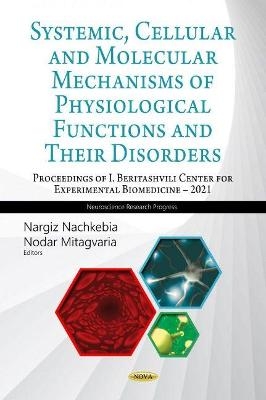The Ivane Beritashvili Center of Experimental Biomedicine was established in 2010 on the basis of the well-known Ivane Beritashvili Institute of Physiology, the most prominent research centre of Georgia, where basic and applied research in different fields of neurophysiology has been conducted since its foundation. Professor Ivane Beritashvili was a famous Georgian scientist who gained international recognition during his lifetime. He was one of the founders and members of the Georgian Academy of Sciences and a member of three academies of sciences of the former Soviet Union. He was an honorary member of the New York Academy of Sciences, the American Society of Electroencephalography, the Royal Society of England, the American Society of Biological Psychiatry, and an honorary member of the International Brain Research Organization. He was an honoured scientist of Georgia, a laureate of the State Prize, and a recipient of many orders and medals. Ivane Beritashvili is remembered in history as a person who founded the Department of Physiology at the newly opened Tbilisi State University. He developed physiological terminology in Georgian, wrote a textbook of physiology in Georgian for the students of the university, raised successful scientists from the first generation of his students, and founded the Georgian School of Physiology. In 1935, he founded the Institute of Physiology in Tbilisi, which soon gained recognition and became well-respected by a wide range of foreign scientists who often visited Georgia. In 2010, three scientific institutions were merged with the Ivane Beritashvili Institute of Physiology -- the Institute of Molecular Biology and Biophysics, the Center of Radiobiology and Radiation Ecology and the Center of Experimental Neurology, the first two of which, for many years, were the departments of the Institute of Physiology. This edited book is the third such compilation containing chapters that represent the research priorities of the Ivane Beritashvili Center of Experimental Biomedicine, which covers the experimental study of fundamental issues in the functioning of physiological (mainly neurophysiological) mechanisms during normal and pathological conditions. The first and second books: "Systemic, Cellular and Molecular Mechanisms of Physiological Functions and Their Disorders" -- published by Nova Science Publishers Inc. in 2015 and 2018, were also devoted to the same general problems. In the present edited book, particular attention is drawn to the study of extremely important processes underlying the basic mechanisms and disorders of various phenomenon of integrative activity of the brain: general behaviIt has to be noted that each chapter, within the collection of works, represents the results of separate, independent studies implemented by different scientific departments of the centre. or, learning and memory, the sleep-wakefulness cycle, regulation of adequate blood supply, hormesis, epilepsy, depression, sleep disorders, pain and analgesia. All of the mentioned processes are studied on the molecular, cellular and systemic levels of their organization. Therefore, the chapters are not directly related to each other and have been arranged alphabetically based on the surname of the authors. The authors would like to take this opportunity to present to the reader the scientific and institutional infrastructure of the centre, which consists of departments and laboratories. Nowadays the center consists of seven departments: Neurophysiology, Membranology, Biochemistry, Blood Circulation and Metabolism, Neurotoxicology, Membranology, Biophysics and Radiobiology and nine laboratories: Neurobiology of Sleep-Wakefulness Cycle, Vision Physiology, Behavior and Cognitive Functions, Brain Ultra- and Nano-Architectonics, Experimental Neurology, Pain and Analgesia, Structure and Functions of Genomes, Bioinformatics, and the Problems of Radiation Safety. In addition to the bilateral scientific cooperation with famous European and U.S. scientific institutions, the centre is a member of the International Science Consortium "From Molecule to Cellular Events in Human Pathologies", the annual meeting of which was held in Tbilisi in 2015. The authors are confident that the readers are fully aware of the theoretical and practical importance of the research related to the problems of systemic, cellular and molecular mechanisms of physiological functions and their disorders. The presented collection of works contains the results of relevant research conducted over the last three years (2019-2021). The authors will be grateful for feedback, recommendations and suggestions regarding their research, in the implementation of which they have invested a lot of effort, knowledge and experience.
Preface; Electromagnetic Stimulation Affects Hypothalamus-pituitary-adrenal Axis to Restore Blood Content in Depressed Rats; Radiobiological Aspects of Secondary Metabolism Research; The Problem of Lead 210Pb in the Manifestation of the Effects of Radon Exposure on Living Organisms: A Conceptual Analysis; Endogenous Opioid and Cannabinoid System Contribute to NSAIDs-Induced Antinociception: I. Anterior Cingulate Cortex; Dual-Task Coordination in Children and Adolescents with Attention Deficit Hyperactivity Disorder (ADHD); Neurophysiological Features of Perception and Processing of Visual Information in Right and Left-Handed People (Age Aspect); Biomimetics Made of α-Amino Acids for Biomedical Use; Description of Similar and Non-similar Rheological Properties during So-Called COVID Toes and Raynauds Phenomenon and Explanation with Mathematical Estimation of Comparison; The Main Mechanisms of Cerebral Blood Flow Autoregulation; Sleep Research Achievements in Georgia Rethinking and Overview of Some Early Significant Facts; About the Neurophysiological Mechanisms for Anti-Anxiety and Sleepiness-Producing Effects of Some Benzodiazepine Drugs; Neocortical Modulation of Experimental Pain; Behavior and Neurochemical Parameters of the Brain Structures in Aggressive and Non-Aggressive Rats as the Predictors of Animal Hierarchical Rank; Space-Time Clustering of Childhood Leukemia in Tbilisi City; TRPA1 Channel is Involved in Non-Histaminergic Itch-Related Thermal and Mechanical Hyperalgesia; Endogenous Opioid and Cannabinoid Systems Contribute to NSAIDs-Induced Antinociception: II. Agranular Insular Cortex; Endogenous Opioid and Cannabinoid Systems Contribute to NSAIDs-Induced Antinociception: III. Central Nucleus of Amygdala; Index.



